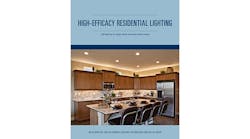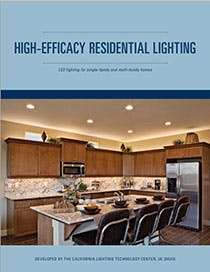The California Lighting Technology Center (CLTC) at the University of California, Davis, published a report that provides a useful guide to specifications and design of lighting systems for energy-efficient homes.
“High-Efficacy Residential Lighting: LED lighting for single-family and multi-family homes,” which can be downloaded at the CLTC website, steps through the main considerations for designing lighting systems in accordance with the lighting section (Part 6) of California’s Title 24 building energy-efficiency standards introduced in 2013. California’s role as an early adopter of environmentally oriented policies make this guide a solid foundation for designing high-efficacy lighting for homes in markets outside California as well.
The Title 24 Part 6 standards require lighting controls in many residential spaces and require that some or all of the luminaires installed in residential kitchens, bathrooms, garages, laundry rooms and utility spaces meet the classification criteria for high-efficacy lighting.
The CLTC guide takes the reader through some lighting design basics and details criteria specific to certain areas of a home. There’s a section on kitchens, bathrooms, garages and laundry rooms and so-forth, with floor plans detailing luminaire placement and control strategies for each as well as light-level targets for different areas of the room.
One interesting point: For the purposes of the California standards, a luminaire that allows a user to replace high-efficacy light sources – primarily light-emitting diode (LED) and compact fluorescent lamps (CFL) – does not qualify even if the more efficient technology is used. Certain CFL and LED lamps don’t necessarily qualify if they’re installed in a screw-base or line-voltage luminaire compatible with any kind of incandescent lamp. Lamps and luminaires that are classified as high-efficacy include luminaires using LED light sources exclusively that have been certified by the California Energy Commission (CEC), GU-24 sockets rated for CFLs or LED lamps, and others.
The guide introduces some basics on lighting control strategies, color characteristics such as color temperature and color rendering, as well as lighting design principles including room cavity ratio (RCR) equations and coefficients of utilization used to help determine the number of lighting products needed to light a space.
The guide also lists a selection of lighting products that are compliant with Title 24, separated into half a dozen basic categories, with color temperature, color rendering, watts and efficacy ratings for each (the list was compiled in Sept. 2014, and is just intended as a sample of the types of lighting certified by the CEC.
Here’s the CLTC’s introduction to the guide: High-Efficacy Residential Lighting Guide
…and the document itself (PDF): HIGH-EFFICACY RESIDENTIAL LIGHTING




